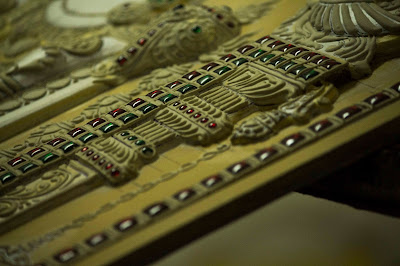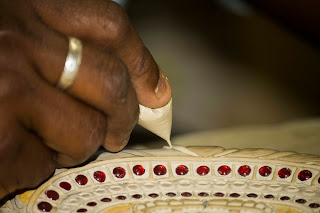Monday, February 20, 2017
The Art Of Tanjore Painting
One of the most popular form of classical South Indian painting, the Tanjore Painting, is know for its elaborate relief work, dense composition and vibrant colors. It’s surface richness and various embellishments distinguishes it from other types of paintings. The subjects of most of the paintings are Hindu deities and saints. Tanjore Painting gets its name from the ancient pronunciation of the place where it originated, which was then called Thanjavur. It originated during the 16th century, under the reign of the Cholas. Tanjore was the capital of the mighty Chola Empire. The Chola rulers besides being great warriors were builders of magnificent temples and great patrons of arts. It was against this setting that this highly specialized form of art with its characteristically beautiful ornamental relief work flourished. Today, hundreds of dedicated artists, mostly based in Tamil Nadu, India, are keeping this age long tradition alive.
One such artist, Raja, has been practicing this craft for the last 16 years. Working from a tiny room in his house located on south mada road, Thiruvanmiyur, he does the relief work before passing it on to another artist who then adds the gold leaf, color and frames the paintings. Due to the commercialization of the craft, the work is divided amongst artisans to increase the output and reduce the time invested on one painting.
Raja begins the process by smoothening the plywood on which muslin is then stuck using fevicol. A layer of chalk powder mixed with fevicol is applied on the cloth and it is left to dry. It is then coated with arabic gum. After the canvas has been prepped, the drawing is traced on from a gateway sheet to ensure uniformity in the work. Tracing the drawing is also done to save time. Once the drawing is done, depending on whether it’s a flat, semi embossed or 3d embossed, the various layers of chalk powder and plaster of paris are applied. The entire process takes him 2-4 days after which it is packed it thermacol and bubble wrap and sent to the next artist for the further process. The next artist sticks the gold foil on using Arabic gum and then finishes the painting with poster paint. The last thing to be painted on are the god/goddesses eyes as it is believed that once they are painted on the god enters the painting.

Over a period of time many changes have occurred in the style and form of painting - for example, the figures are no longer too round, showing the changed preferences in body structures. Presiding deities of various famous temples are also being depicted in the more recent paintings.

Contact
Name - Mr. Raja
Contact Number - +(91)-9840541546
Address - 48/67a, South mada street, Thiruvanmiyur, Chennai - 600041, Opposite alm Pranav hotel
Documented by Anushka Harish Salian
Subscribe to:
Post Comments (Atom)






No comments:
Post a Comment